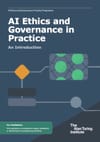📘 What’s Covered
This workbook serves as both a curriculum guide and capacity-building tool for public servants and AI practitioners interested in ethical AI adoption. Structured in two main parts—Key Concepts and Activities—it aims to build practical understanding through both theoretical content and participatory learning.
Part 1: Key Concepts
The first section demystifies AI and ML, covering:
- What is AI?: Defined not as a static concept, but by the role systems play in decision-making typically reserved for humans (pg. 10).
- Applications: Diverse real-world use cases across healthcare, education, transport, and public administration (pp. 12–13).
- Technical Fundamentals: Concepts like data types, model training, supervised/unsupervised/reinforcement learning, and project lifecycles are clearly explained with accessible examples and visuals (pp. 14–27).
- Sociotechnical Framing: Emphasizes that AI systems are always shaped by social, institutional, and ethical contexts (pp. 31–33).
- Governance Frameworks:
- CARE and Act Framework introduces a reflective model for Responsible Research and Innovation (pg. 34).
- SUM Values (Respect, Connect, Care, Protect) provide a moral compass.
- SSAFE-D Principles translate ethics into six operational goals: Sustainability, Safety, Accountability, Fairness, Explainability, and Data Stewardship (pg. 38).
- PBG Framework visualizes where to apply these principles throughout an AI/ML project (pg. 40).
Part 2: Activities
This section includes five workshop-ready exercises that align with the content. Activities include:
- Developing a team’s “Collective Image of AI”
- Mapping the AI/ML lifecycle
- Practicing ethical deliberation using the CARE and Act FrameworkEach is designed with facilitators in mind, providing clear instructions and timelines (pp. 43–57).
💡 Why it matters?
AI ethics discussions often get stuck at abstract values. This workbook breaks that cycle by making ethics practical, iterative, and team-based. It doesn’t just say “be fair”—it helps teams operationalize fairness with specific governance tools and checklists. Especially in the public sector, where legitimacy and transparency matter, this kind of structured, participatory approach can make or break trust in AI projects.
🧩 What’s Missing
While rich in pedagogy and design, this workbook does assume a relatively consistent team structure and institutional readiness for structured reflection. It’s geared more toward public sector contexts in the UK and may need adaptation for international or private sector settings. Also, while it references adjacent workbooks in the series, it could benefit from clearer modular integration—i.e., how this “intro” links concretely with each thematic workbook (on fairness, explainability, etc.).
👥 Best For
Perfect for AI project managers, policy officers, or data teams in government looking to embed ethical reflection into workflows. Facilitators tasked with internal training or workshop design will find this especially helpful. Less suitable for technical audiences seeking code or algorithm-specific standards.
📎 Source Details
- Title: AI Ethics and Governance in Practice: An Introduction
- Authors: David Leslie et al.
- Publisher: The Alan Turing Institute (2023)
- Link: https://www.turing.ac.uk/ai-ethics-governance


